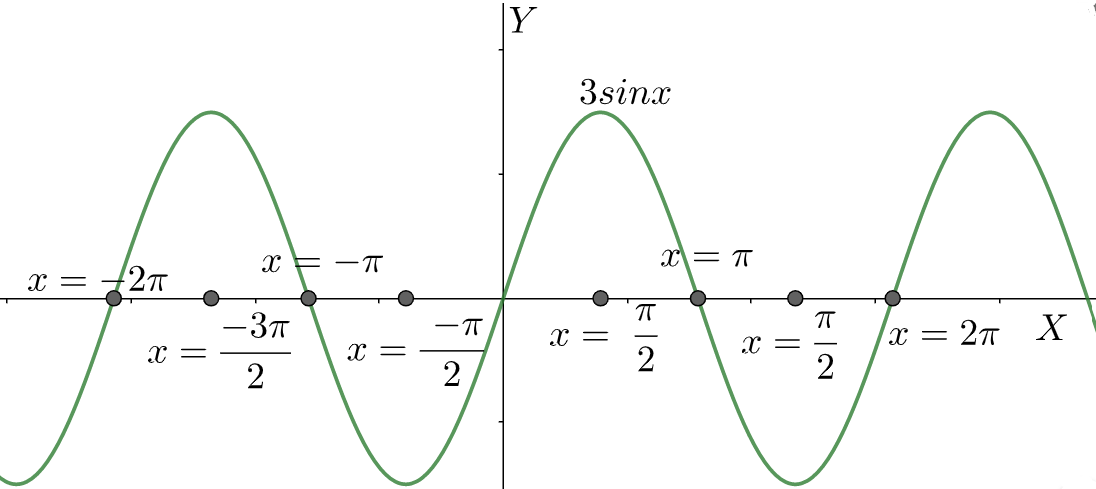
How do you find the amplitude, period, and phase shift of \[y=3\sin x\] ?
Answer
498.3k+ views
Hint: These types of trigonometric problems are pretty easy to solve and they are very straight forward. To find the amplitude, period and other things we first need to define the general equation of \[\sin x\] , which is defined as, \[y=A\sin \left( bx+c \right)+d\] . From this general equation we can find out all our required outputs accordingly.
Complete step by step answer: Now we start off our given solution, by writing the general form of the equation, \[y=A\sin \left( bx+c \right)+d\] , and from this, each and every variable represents some of the output values, which affect the nature of the graph of \[y=3\sin x\]. In the defined equation,
\[A\], represents, the amplitude,
From \[y=A\sin \left( bx+c \right)+d\] we can find the period of the function by using the formula of period of \[\sin x\] that \[period=\dfrac{\left| 2\pi \right|}{b}\]
\[c\] , represents the horizontal phase shift or phase shift and,
\[d\] , represents the vertical phase shift.

Now, writing our given equation of the form of the general defined one we get,
\[y=3\sin \left( 1.x+0 \right)+0\],
From this equation, we can write, that the Amplitude of the function is defined as,
\[A=3\]
We can also conclude that the value of the period of the function is defined as,
\[\begin{align}
& period=\dfrac{\left| 2\pi \right|}{1} \\
& \Rightarrow period=2\pi \\
\end{align}\]
We can conclude that the value of the phase shift or the horizontal shift of the function is given by,
\[c=0\] .
Note: While solving these types of problems, we must be very careful in representing the general form of the equation properly. Once the general form is represented correctly, we can find all the necessary things by comparing the given equation with the general form. We also need to remember all the variables and parameters, and what variables represent what.
Complete step by step answer: Now we start off our given solution, by writing the general form of the equation, \[y=A\sin \left( bx+c \right)+d\] , and from this, each and every variable represents some of the output values, which affect the nature of the graph of \[y=3\sin x\]. In the defined equation,
\[A\], represents, the amplitude,
From \[y=A\sin \left( bx+c \right)+d\] we can find the period of the function by using the formula of period of \[\sin x\] that \[period=\dfrac{\left| 2\pi \right|}{b}\]
\[c\] , represents the horizontal phase shift or phase shift and,
\[d\] , represents the vertical phase shift.

Now, writing our given equation of the form of the general defined one we get,
\[y=3\sin \left( 1.x+0 \right)+0\],
From this equation, we can write, that the Amplitude of the function is defined as,
\[A=3\]
We can also conclude that the value of the period of the function is defined as,
\[\begin{align}
& period=\dfrac{\left| 2\pi \right|}{1} \\
& \Rightarrow period=2\pi \\
\end{align}\]
We can conclude that the value of the phase shift or the horizontal shift of the function is given by,
\[c=0\] .
Note: While solving these types of problems, we must be very careful in representing the general form of the equation properly. Once the general form is represented correctly, we can find all the necessary things by comparing the given equation with the general form. We also need to remember all the variables and parameters, and what variables represent what.
Recently Updated Pages
NCERT Solutions For Class 12 Maths Miscellaneous Exercise - Application Of Integrals

NCERT Solutions For Class 12 Maths Vector Algebra Exercise 10.4

NCERT Solutions For Class 12 Maths Differential Equations Exercise 9.1

NEET Physics Mock Test 2025: Free Practice & Solutions

NCERT Solutions For Class 6 Hindi Malhar - Rahim Ke Dohe

NCERT Solutions For Class 12 Maths Miscellaneous Exercise - Probability

Trending doubts
1 ton equals to A 100 kg B 1000 kg C 10 kg D 10000 class 11 physics CBSE

Difference Between Prokaryotic Cells and Eukaryotic Cells

One Metric ton is equal to kg A 10000 B 1000 C 100 class 11 physics CBSE

1 Quintal is equal to a 110 kg b 10 kg c 100kg d 1000 class 11 physics CBSE

Proton was discovered by A Thomson B Rutherford C Chadwick class 11 chemistry CBSE

Draw a diagram of nephron and explain its structur class 11 biology CBSE




